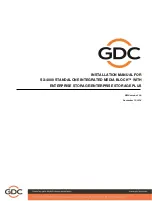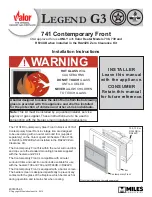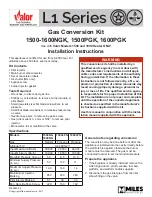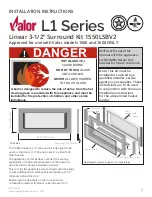
F2893 1-089 V3.0 ©MMVII Muscle Wires®
and Flexinol® are registered trademarks of Dynalloy
The FrankenSerial Interface extends the input
/ output (I/O) capabilities of the BASIC
Stamp single-board computer, or any
computer capable of communicating via 2400
or 9600 baud serial. The computer reads and
writes the Interface’s 16 I/O pins using the
Serin and Serout commands. The Stamp can
also read the Interface’s eight-bit analog-to-
digital converter (ADC), which can measure
voltages between 0 and 4.7V DC and return a
proportional value of 0 to 255.
Kit requires soldering, basic tools and a PC
with parallel port.
HT Alloy Thermal
Cycle Rate
(cyc/min
9
55
50
Thermal
Activation Start
Temp. (
°
C)
Activation Finish
Temp. (
°
C)
Relaxation Start
Temp. (
°
C)
Relaxation Finish
Temp. (
°
C)
Annealing Temp.
(
°
C)
Melting Temp.
(
°
C)
Specific Heat
(cal/g
°
C)
Heat Capacity
(Joule/g
°
C)
Latent Heat
(Joule/g)
LT Alloy
68
78
52
42
300
1,300
0.077
0.32
24.2
HT Alloy
88
98
72
62
300
1,300
0.077
0.32
24.2
Material
Density (g/cc)
Maximum Recovery
Force (MPa)
Recommended
Deformation Force
(MPa)
Breaking Strength
(MPa)
Poisson’s Ratio
Work Output (Joule/g)
Energy Conversion
Efficiency (%)
Maximum Deformation
Ratio (%)
Recommended
Deformation Ratio (%)
6.45
600
35
1,000
0.33
1
5
8
3-5
(~43 ton /
in
2
)
(~2.5 ton
/ in
2
)
(~71 ton /
in
2
)
Phase Related
Phase
Resistivity (
µ
Ω
cm)
Young’s Modulus
(GPa)
Magnetic
Susceptibility
(
µ
emu/g)
Thermal
Conductivity
(W/cm
°
C)
Martensite
76
28
2.5
0.08
Austenite
82
75
3.8
0.18
™
1.0 Introduction
FrankenSerial Interface Kit
Muscle Wires® Moving Electronics Kit
2.0 Parts List
The kit includes the following:
Item
Quan
Location Description
1.
1
R2
Resistor 470
Ω
1/4w 5%, yel vio brn gold
2.
3
R3, R5, R7 Resistor 100K
Ω
1/4w 5%, brn blk yel gold
3.
2
R4, R6
Resistor 1.0K
Ω
1/4w 5%, brn blk red gold
4.
1
R8
Resistor 220
Ω
1/4w 5%, red red brn gold
5.
2
C1, C2
Capacitor ceramic mono 0.1µF 50v 20% radial Z5U
6.
2
J4, J5
Socket 1 x 10 SIP
7.
1
U1
Socket 8-pin DIP
8.
1
U2
Socket 28-pin DIP
9.
1
J1
Header, Male 0.100” 1 x 3
10.
2
J2, BPS
Header, Male 0.100” 1 x 2
11.
2
J3, J6
Header, Male 0.100” 2 x 8
12.
1
CR1
Resonator 4MHz with caps
13.
1
U3
IC MN1381 Low Voltage Detect & Reset
14.
1
U1
IC ADC0831 A/D Converter 8-bit Serial I/O
15.
1
U2
IC PIC16C55-XT/P, Programmed
16.
1
BPS
Shorting Block (Jumper) 0.1”
17.
1
-
PCB, Stamp Stretcher 1B, Rev -
18.
1
-
Instructions, FrankenSerial Interface (these!)
Note: Resistor R1 and diode D1 are not required for operation and not included in this kit. See page 3
"Using and reconfiguring the ADC" for details.
3.0 Other Tools and Materials List
In addition, assembly and operation will require:
1.
Soldering iron for electronics
2.
Solder for electronics
3.
Moist sponge to clean soldering iron tip
4.
Side cutter
5.
Stamp or other computer with 2400 or 9600 baud communication
6.
Power source, 5 Volts DC, 5 mA (Stamp 1, Stamp 2, etc.)
4.0 Assembly
The FrankenSerial Interface is an input/output (I/O) extender for the BASIC Stamp single board
computer. The Stamp reads and writes the Interface’s 16 I/O pins using the Serin an Serout
commands. The Stamp can also read the Interface’s onboard eight-bit analog to digital converter
(ADC). The ADC is capable of measuring voltages between 0 and 4.7 Vdc and returning a
proportional value from 0 to 255. The Interface operates at 2400 or 9600 baud.
5.0 Using the FrankenSerial Interface
Generally, assemble the Printed Circuit Board starting with components having the lowest height
above the board, and work upwards - as per the order given in the parts list. Note both the location of
the part (don't put it in the wrong place), and its orientation. Many parts, like diodes and integrated
circuits, can be damaged or destroyed if powered “the wrong way”.
Configuring and connection the Interface to the BASIC Stamp 1
The Interface communicates with the BASIC Stamp through one
Stamp I/O pin. All of the examples here use in 0, but you may use
any available Stamp 1 pin, 0 through 7. You can power the Interface
from the Stamp’s voltage regulator, since the Interface draws less
than 5 mA. However, if you are driving loads with the Interface
and/or the Stamp, make sure that their total current draw doesn’t
exceed the regulator’s 50-mA capacity. If it does, you will need an
external voltage regulator. Figure 1 shows a typical Stamp-to-
Interface connection, using power supplied by the Stamp’s voltage regulator.
The Interface normally operates at 2400 baud – the maximum speed of the original Stamp
and BS1-IC. If you install a shorting jumper on the posts marked BPS, the Interface will
operate at 9600 baud. The Interface only checks BPS at startup; if you install or remove a
jumper while the Interface is powered up, the change won’t take effect until it is turned off
and back on.
Using the digital I/O pins
The Interface’s 16 I/O pins, numbered 0 through 15, are connected to
header stakes at J3 and J6 on the circuit board as shown in figure 2.
The Interface’s I/O lines are electrically identical to those of the
Stamp. When set to output, a pin can source 20 mA and sink 25 mA,
for a total of up to 40 mA (source) or 50 mA (sink) per port.
Interface pins 0 through 7 comprise the “lower” port; pins 8 through
15 are the “higher” port.
When set to input, the Interface’s pins have very high impedance,
leaking no more than 1
µ
A of current in or out, provided input
voltages aren’t more negative than ground, or more positive than the
+ power supply.
Next to the I/O-in headers are 10-conductor inline sockets J4 and J5.
These sockets are also connected to the I/O pins, but have an























